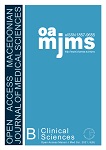NT pro- B-type Natriuretic Peptide in the Small Ventricular Septal Defect in Children
DOI:
https://doi.org/10.3889/oamjms.2021.7592Keywords:
NT pro B-type natriuretic peptide, Peri membranous ventricular septal defect, ChildrenAbstract
Background: Brain natriuretic peptide is a cardiac hormone secreted from the left ventricular myocardium due to ventricular expansion and volume overload. A recent study shows that small VSD will have risk of ventricular dysfunction in adulthood. Another complications such as endocarditis, congestive heart failure, aortic regurgitation, arrhythmia also we should be aware. Evaluations of the plasma B-type natriuretic peptide level (NT pro BNP) are currently being considered as methods to identify the possible presence of ventricular dilation in small VSD.
Objective: To evaluate the change in plasma B-type natriuretic peptide after transcatheter closure of VSD.
Methods: A pretest-posttest design was conducted on VSD patients before and after transcatheter closure. Plasma B-type natriuretic peptide level were measured before and 30 days after the transcatheter closure of VSD.
Result: A total of 32 peri membranous VSD patients were included in this study with 62.5 % female patients (n=20) and 37.5 % male patients (n=12). A significant decrease was observed in the median NT pro BNP level when the level before closure of 1.08 (0.74 – 3.47) ng/ml was compared to the level after closure of 0.91 (0.68 – 2.07) ng/ml (p<0.05).
Conclusion: Significant decreases in NT pro BNP level are seen in small VSD patients 30 days after transcatheter closure. Patients with small peri membranous VSD are generally considered to need occlusion for their childhood defect.
Downloads
Metrics
Plum Analytics Artifact Widget Block
References
Jacob J, Chopra S, Cherian D, Verghese P. Physiology and clinical significance of natriuretic hormones. Indian J Endocrinol Metab. 2013;17(1):83. https://doi.org/10.4103/2230-8210.107869 PMid:23776857 DOI: https://doi.org/10.4103/2230-8210.107869
Otterstad J, Erikssen J, Michelsen S, Nitter-Hauge S. Long-term follow-up in isolated ventricular septal defect considered too small to warrant operation. J Intern Med. 1990;228(4):305-9. https://doi.org/10.1111/j.1365-2796.1990.tb00237.x PMid:2266337 DOI: https://doi.org/10.1111/j.1365-2796.1990.tb00237.x
Kidd L, Driscoll D, Gersony W, Hayes C, Keane J, O’Fallon W, et al. Second natural history study of congenital heart defects. Results of treatment of patients with ventricular septal defects. Circulation. 1993;87 Suppl 2:I38-51. PMid:8425321
Neumayer U, Stone S, Somerville J. Small ventricular septal defects in adults. Eur Heart J. 1998;19(10):1573-82. https://doi.org/10.1053/euhj.1998.1083 PMid:9820997 DOI: https://doi.org/10.1053/euhj.1998.1083
Ross R, Bollinger R, Pinsky W. Grading the severity of congestive heart failure in infants. Pediatr Cardiol. 1992;13(2):72-5. https://doi.org/10.1007/BF00798207 PMid:1614922 DOI: https://doi.org/10.1007/BF00798207
Ali Y, Hassan M, Fiky A. Assessment of left ventricular systolic function after VSD transcatheter device closure using speckle tracking echocardiography. Egypt Hear J. 2019;71(1):1. https://doi.org/10.1186/s43044-019-0001-7 PMid:31659511 DOI: https://doi.org/10.1186/s43044-019-0001-7
Gersony W, Hayes C, Driscoll D, Keane J, Kidd L, O’Fallon W, et al. Second natural history study of congenital heart defects. Quality of life of patients with aortic stenosis, pulmonary stenosis, or ventricular septal defect. Circulation. 1993;87 Suppl 2:I52-65. PMid:8425323
Karonis T, Scognamiglio G, Narayan S, Montanaro C, Uebing A, Diller G, et al. Clinical course and potential complications of small ventricular septal defects in adulthood: Late development of left ventricular dysfunction justifies lifelong care. Int J Cardiol. 2016;208:102-6. https://doi.org/10.1016/j.ijcard.2016.01.208 PMid:26844920 DOI: https://doi.org/10.1016/j.ijcard.2016.01.208
Kaya Y, Akdemir R, Gunduz H, Murat S, Bulut O, Kocayigit I, et al. Changes in serum natriuretic peptide levels after percutaneous closure of small to moderate ventricular septal defects. ScientificWorldJournal. 2012;2012:328697. https://doi.org/10.1100/2012/328697 PMid:22629130 DOI: https://doi.org/10.1100/2012/328697
Suda K, Matsumura M, Matsumoto M. Clinical implication of plasma natriuretic peptides in children with ventricular septal defect. Pediatr Int. 2003;45(3):249-54. https://doi.org/10.1046/j.1442-200x.2003.01716.x PMid:12828576 DOI: https://doi.org/10.1046/j.1442-200X.2003.01716.x
Fernandes B, Maher K, Deshpande S. Cardiac biomarkers in pediatric heart disease: A state of art review. World J Cardiol. 2016;8(12):719-27. https://doi.org/10.4330/wjc.v8.i12.719 PMid:28070239 DOI: https://doi.org/10.4330/wjc.v8.i12.719
Farouk A, Alogwhary M, Hassan M, El-minshawy A. Circulating B-type natriuretic peptide levels and its correlation to Qp/Qs ratio among children undergoing congenital heart surgery- NC-ND license. J Egypt Soc Card Surg. 2017;25:58-63. https://doi.org/10.1016/j.jescts201 DOI: https://doi.org/10.1016/j.jescts.2017.03.002
Weber M, Hamm C. Role of B-type natriuretic peptide (BNP) and NT-proBNP in clinical routine. Heart. 2006;92(6):843-9. https://doi.org/10.1136/hrt.2005.071233 PMid:16698841 DOI: https://doi.org/10.1136/hrt.2005.071233
Kim HS, Choi HJ. N-terminal pro-B-type natriuretic peptide levels in children: Comparison in cardiac and non-cardiac diseases. Cardiol Young. 2020;30(4):500-4. https://doi.org/10.1017/S1047951120000402 PMid:32102709 DOI: https://doi.org/10.1017/S1047951120000402
Mehta AV, Goenka S, Chidambaram B, Hamati F. Natural history of isolated ventricular septal defect in the first five years of life. Tenn Med. 2000;93(4):136-8. PMid:10754804
Miyake T, Shinohara T, Fukuda T, Ikeoka M, Takemura T. Spontaneous closure of perimembranous ventricular septal defect after school age. Pediatr Int. 2008;50(5):632-25. https://doi.org/10.1111/j.1442-200X.2008.02642.x PMid:19261109 DOI: https://doi.org/10.1111/j.1442-200X.2008.02642.x
Cantinotti M, Assanta N, Murzi B, Lopez L. Controversies in the definition and management of insignificant left-to-right shunts. Heart. 2014;100(3):200-5. https://doi.org/10.1136/heartjnl-2013-304372 PMid:23886608 DOI: https://doi.org/10.1136/heartjnl-2013-304372
Hart JP, Cabreriza SE, Walsh RF, Printz BF, Blumenthal BF, Park DK, et al. Echocardiographic analysis of ventricular geometry and function during repair of congenital septal defects. Ann Thorac Surg. 2004;77(1):53-60. https://doi.org/10.1016/S0003-4975(03)01328-6 PMid:14726034 DOI: https://doi.org/10.1016/S0003-4975(03)01328-6
Baghdady Y, Kamel Y, Amar W. Myocardial performance index after surgical correction of ventricular septal defects. Arch Med Sci. 2010;6(3):328-35. https://doi.org/10.5114/aoms.2010.14251 PMid:22371767 DOI: https://doi.org/10.5114/aoms.2010.14251
Mongeon F, Burkhart H, Ammash N, Dearani J, Li Z, Warnes C, et al. Indications and outcomes of surgical closure of ventricular septal defect in adults. JACC Cardiovasc Interv. 2010;3(3):290-7. https://doi.org/10.1016/j.jcin.2009.12.007 PMid:20298987 DOI: https://doi.org/10.1016/j.jcin.2009.12.007
Gabriel HM, Heger M, Innerhofer P, Zehetgruber M, Mudigler G, Wimmer M, et al. Long-term outcome of patients with ventricular septal defect considered not to require surgical closure during childhood. J Am Coll Cardiol. 2002;39(6):1066-71. https://doi.org/10.1016/s0735-1097(02)01706-0 PMid:11897452 DOI: https://doi.org/10.1016/S0735-1097(02)01706-0
Pawelec-Mojtalik M, Wojtalik M, Mrówczyński W, Sumarcz R. Closure of perimembranous ventricular septal defect using transcatheter technique versus surgical repair. Kardiol Pol. 2005;63(6):595-602. PMid:16380857
Downloads
Published
How to Cite
Issue
Section
Categories
License
Copyright (c) 2020 Rahmat Budi Kuswiyanto, Putria Apandi, Dany Hilmanto, Muhammad Hasan Bashari, Sri Endah Rahayuningsih (Author)

This work is licensed under a Creative Commons Attribution-NonCommercial 4.0 International License.
http://creativecommons.org/licenses/by-nc/4.0








